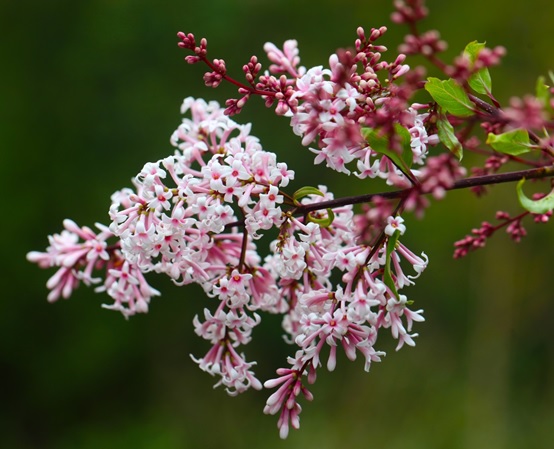Lilacs (Syringa L.), a group of well-known ornamental and aromatic woody plants mainly distributed in Asia and Europe, have long been used for gardening, essential oils and medicine purposes in East Asia and Europe.
Researchers from the Institute of Botany of Chinese Academy of Sciences have assembled the whole genome of the widespread species Syringa oblata, and further revealed chromosome evolution of Oleaceae, biogeographic dispersal, phylogenetic relationship and scent formation of Syringa.
This study was published on The Plant Journal.
In this study, the researchers assembled a high-quality S. oblata genome with 1.12 Gb in size including 53,944 protein coding genes. They found that a recent duplication event and parallel evolution of two subgenomes contributed the chromosome formation in Oleaceae.
They also indicated that S. oblata shared a common ancestor with Osmanthus fragrans and Olea europaea ~27.61 million years ago.
Moreover, they demonstrated that Syringa originated in the northern part of East Asia during the Miocene (~14.73 Mya) and then occurred multidirectional dispersals accompanied by gene introgression among Syringa species in Northern China during the Miocene.
Meanwhile, the researchers outlined a complete phylogenetic pedigree for Syringa. They showed that segment and tandem duplications contributed to scent formation in the woody aromatic species. Researchers also found that expansion of the TPS and MYB gene families contributed to the floral scent formation in S. oblata.
"This study not only put a new insight on the evolution history of S. oblate from a biological and geographical perspective, but provide an opportunity to improve ornamental characteristics and explore medicinal functions of lilacs." said Dr. CUI Hongxia, one of the correspondence authors.
This study was supported by the National Natural Science Foundation of China.

Syringa sweginzowii, an endemic species in the west of Sichuan Province, China, is a representative of Series Villosae with a narrow geographical distribution only in Hengduan Mountains. (Image by IBCAS)
Article link: https://onlinelibrary.wiley.com/doi/epdf/10.1111/tpj.15858
Contact:
Hongxia Cui
Institute of Botany, the Chinese Academy of Sciences,
20 Nanxincun, Xiangshan, Beijing 100093, China
E-mail: huyuxin@ibcas.ac.cn
Lilacs (Syringa L.), a group of well-known ornamental and aromatic woody plants mainly distributed in Asia and Europe, have long been used for gardening, essential oils and medicine purposes in East Asia and Europe.
Researchers from the Institute of Botany of Chinese Academy of Sciences have assembled the whole genome of the widespread species Syringa oblata, and further revealed chromosome evolution of Oleaceae, biogeographic dispersal, phylogenetic relationship and scent formation of Syringa.
This study was published on The Plant Journal.
In this study, the researchers assembled a high-quality S. oblata genome with 1.12 Gb in size including 53,944 protein coding genes. They found that a recent duplication event and parallel evolution of two subgenomes contributed the chromosome formation in Oleaceae.
They also indicated that S. oblata shared a common ancestor with Osmanthus fragrans and Olea europaea ~27.61 million years ago.
Moreover, they demonstrated that Syringa originated in the northern part of East Asia during the Miocene (~14.73 Mya) and then occurred multidirectional dispersals accompanied by gene introgression among Syringa species in Northern China during the Miocene.
Meanwhile, the researchers outlined a complete phylogenetic pedigree for Syringa. They showed that segment and tandem duplications contributed to scent formation in the woody aromatic species. Researchers also found that expansion of the TPS and MYB gene families contributed to the floral scent formation in S. oblata.
"This study not only put a new insight on the evolution history of S. oblate from a biological and geographical perspective, but provide an opportunity to improve ornamental characteristics and explore medicinal functions of lilacs." said Dr. CUI Hongxia, one of the correspondence authors.
This study was supported by the National Natural Science Foundation of China.

Syringa sweginzowii, an endemic species in the west of Sichuan Province, China, is a representative of Series Villosae with a narrow geographical distribution only in Hengduan Mountains. (Image by IBCAS)
Article link: https://onlinelibrary.wiley.com/doi/epdf/10.1111/tpj.15858
Contact:
Hongxia Cui
Institute of Botany, the Chinese Academy of Sciences,
20 Nanxincun, Xiangshan, Beijing 100093, China
E-mail: huyuxin@ibcas.ac.cn
